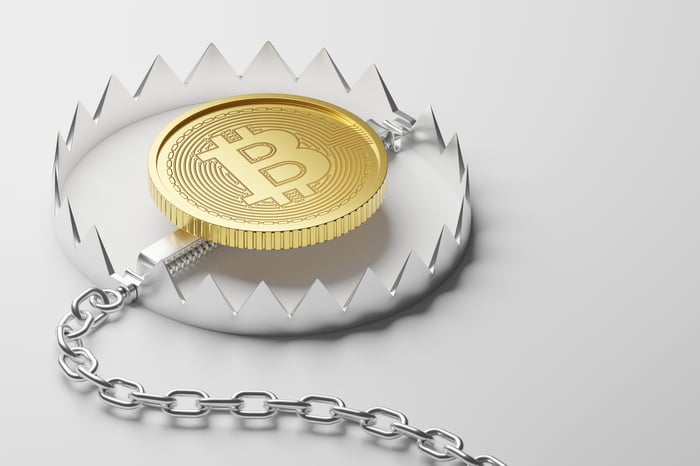Seemingly out of nowhere, January has seen an incredible rally in the crypto market. Bitcoin (BTC -1.00%), of course, is up 37.57% over the past 30 days.
But it's not just Bitcoin -- just about every crypto across the board is up. Some of the biggest gainers have been metaverse cryptos, gaming cryptos, and meme coins.
And that's exactly what concerns me. Weren't we just talking about "crypto winter" a few weeks ago, and bemoaning the economy's chances for higher inflation and a grinding recession? Whenever sentiment shifts overnight like this, I'm always skeptical. So I'm convinced that this January crypto rally can't possibly last. But if you're a Bitcoin investor, that might be good news, because "buying the dip" has proven to be a successful strategy for Bitcoin investors who use a dollar-cost averaging strategy.

Image source: Getty Images.
Mixed signals for Bitcoin
Almost nobody can agree on which metric or indicator is the best for predicting the future direction of Bitcoin. For example, some long-term investors focus on macroeconomic numbers and assess the risk of the Federal Reserve tightening monetary policy again. Others focus on popular blockchain and crypto metrics, such as the amount of Bitcoin flowing into and out of the wallets of the wealthiest investors, known as Bitcoin whales.
As a result, there are two primary camps when it comes to Bitcoin. On one hand, you have the Bitcoin bears, who think that Bitcoin is now in a "bull trap." On the other hand, you have the Bitcoin bulls, who now think that Bitcoin is on a rocket ship headed to $100,000. Of course, there are some investors who are in the middle, or who are holding onto Bitcoin for other reasons, but the extremes do seem to dominate any discussion of Bitcoin.
Bitcoin's four-year cycles
Longtime crypto investors know that Bitcoin has historically followed a four-year cycle. The timing is not perfect, of course, and there is some discussion about whether this pattern is getting weaker over time, but there is definitely a pattern.
There were Bitcoin crashes in 2014 and 2018, so it makes perfect sense (in hindsight) that 2022 also saw a crash. But that also means that there were rallies in 2015 and 2019, and I think that's where we should be looking for real clues as to what's going to happen next with Bitcoin.
According to some analysts, it's beginning to look a lot like 2019. As soon as the Fed stopped tightening in 2019, Bitcoin went on a major rally, rising 247%. While past performance is no guarantee of future performance, some traders do believe that Bitcoin's performance in 2019 could foreshadow what happens in 2023. A lot depends on the Fed, of course, so if you're going to follow any metric or indicator, keep an eye on monetary policy.
Bitcoin's four-year cycles are not a coincidence. Due to an event that happens every four years known as the halving, Bitcoin does tend to run in these four-year cycles, and that has been the case since the first Bitcoin halving in 2012. With each halving, the size of the reward for mining a block of Bitcoin falls by one-half, and this changes the dynamics of the Bitcoin market.
This halving might seem like an esoteric blockchain event, but it has real-world consequences for investor perceptions of Bitcoin. For example, cutting the mining reward by one-half introduces additional scarcity for Bitcoin, and reminds long-term investors that the total supply of Bitcoin is capped at 21 million coins.
In the 16-month period before every halving, Bitcoin tends to appreciate in price. In fact, California-based crypto hedge fund Pantera Capital has modeled this phenomenon and predicted that ahead of the next Bitcoin halving, scheduled for April 2024, Bitcoin will steadily rise in price in 2023 before exploding in value to $149,000. Of course, past performance is no guarantee of future performance. Investors should be buying and holding for the long haul, and not attempting to time the market based on past data.
Buy the dip
Bitcoin's historic volatility also means that it rarely goes straight up. That's why I'm so convinced that there will be at least one more dip before we're done in 2023. This dip will bring out the last of the Bitcoin bears, who have been hibernating this entire crypto winter, just waiting for a chance to wake up and tell the investing world, "See, I told you that Bitcoin was going to collapse..."
Sometime soon, the next "buy the dip" opportunity will present itself. If you are dollar-cost averaging, you will be prepared. Instead of timing the market, you will simply be following through on your long-term investment strategy. As we've seen in the past, this approach to buying Bitcoin can be enormously successful for those willing to buy and hold for the long run.





